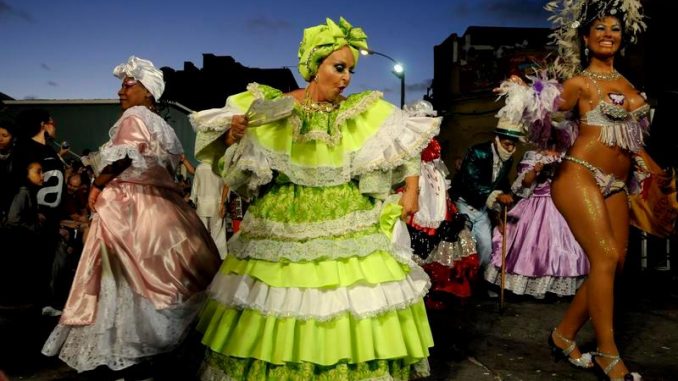
A woman dressed as a Mama Vieja character, center, dances candombe a traditional Afro-Uruguayan rhythm during the Las Llamadas carnival parade in Montevideo, Uruguay,Friday, Feb. 4, 2011. Candombe is an Uruguayan rhythm and its roots can be traced back to the 1700’s when African slaves were brought to Uruguay. Afro-Uruguayan” refers to Uruguayans of Black African ancestry ( “Afrodescendientes”). They are estimated to be about 190,000 and constitutes 10% of the population according to UN and World Bank Reports. They are mainly concentrated in the city of Montevideo. The blacks came to Uruguay as slaves, ladinos–hispanized slaves, in 1534, but eventually settled in Argentina.
AFRICAN DESCENDANTS IN URUGUAY (AFRO-URUGUAYANS)
In his book ” Blackness in the White Nation: A History of Afro-Uruguay,” George Reid Andrews aver that the beauty of Blackness in the White Nation of Uruguay lies in the compelling history of candombe (African music and dance) and in particular the way candombe signify the relationship between blackness and national consciousness in Uruguay and throughout the Americas comparatively.
Economically they remain among the poorest sectors of Uruguayan society: most are non-qualified workers employed in the construction industry, domestic service, or cleaning and porter services. There is high unemployment among young Afro-Uruguayans
When we think of the great nations of the African diaspora—Brazil, Cuba, Haiti, the United States—the South American republic of Uruguay is not one of the first names to come to mind. To the contrary: the recipient of almost 600,000 European immigrants between 1880 and 1930, Uruguay has long presented itself to the world as one of the two “white republics” of South America (its neighbor Argentina is the other). In the national household survey of 1996, 93 percent of its citizens classified themselves as white, a figure significantly higher than in the United States (where 75 percent of the population classified itself as white in the 2000 census).
Yet in common with other Latin American countries, during the last 25 years Uruguay has experienced a significant upsurge in black civic and political mobilization. Organizations such as Mundo Afro (Afro World), the Asociación Cultural y Social Uruguay Negro, the Centro Cultural por la Paz y la Integración, Africanía, and others have pressed the nation to acknowledge its black past and present and to work toward the full integration of its black and indigenous minorities into national life.
These recent organizations are the latest chapter in a long history of black mobilization that began in the early 1800s with the salas de nación, mutual aid societies organized on the basis of members’ African origins. Uruguay’s capital, Montevideo, was a required port of call for slave ships bringing Africans to the Río de la Plata region. Most of those Africans continued on to Argentina, but during the late 1700s and early 1800s some 20,000 disembarked in Montevideo and remained in Uruguay. By 1800 the national population was an estimated 25 percent African and Afro-Uruguayan.
BY: Kweku Darko Ankrah
